Pages from a Diary: Lofoten 1936

Wednesday, 01 April
The destination of this voyage is Lofoten and the boat is called ”Irma” – just like Mrs Nesch. I am writing this while the ”Irma” crosses the fjords, and the radio is playing the sounds of Jacha Heifetz. The loudspeaker has provided the entertainment since this morning. This is what is known as civilisation. I remember the first time I heard Heifetz; in Munich just before we left to attend the so-called Hungary Ball. Since then I had heard him perform at the Aulaen in Oslo. Heifetz is the greatest violinist I know of, and even here in the far, far north and in spite of the mechanical rendering, his tones are no less enchanting. On Sunday evening; Nesch had invited a flock of young artists to “Villa Grønsund”. Among the guests were the painters Erling Enger, Sigurd Winge, Olav Strømme and Borg the Swede with lady friends. Accompanying Borg was his fiancée, called Birgit, according to the woodcut Edvard Munch had made of her. She was quite captivating, delicate, poignant and tiny like H.C. Andersen’s Thumbelina. But I digress, it is the journey I wish to tell about.
A masted rowboat on its way into the port in Kræmmerviken. Rolf Nesch etching on the coastal steamer at the quay in Trondheim. On Monday, there was a dinner to celebrate the departure next morning, after which we packed our suitcases. I was so excited I almost couldn’t sleep. The next day after office hours (we had just received an order from a German leather factory) we accompanied Lindeman and Nesch to the “Blom”, where naturally we met Pola Gauguin. Gauguin had a permanently reserved table on the “Blom”. Lindeman bought a round of drinks – ‘one for the road’. Then we made our way to Østbanen, central railway station. Nesch had a seat in one of the carriages, I had a sleeper 3rd class.
7.30am – Trondheim. Rain. Nonetheless, we thought the city was beautiful, and more Norwegian than Oslo. We deposited our luggage on the “Irma” and walked through the wide streets of the city to the famous cathedral that so enamoured Nesch. He was particularly taken by the building material, which according to Baedeker, was soapstone and marble from an island in North Norway. Beautiful old figureheads and banded patterns. Nesch immediately began etching on his small glistening copper plates. Then we had breakfast at the port.
Just slightly behind schedule, our spacious yet cosy boat, the “Irma” sailed from the port after having loaded on board oranges, light bulbs and a whole menagerie of other essential items. At half past eleven the journey began as we sailed through the Trondheimsfjord amidst a spell-binding landscape under crystal-clear skies. Fishing boats. Tiny hamlets. Lighthouse. Rocks protruding above the waters’ surface like small, stranded whales.
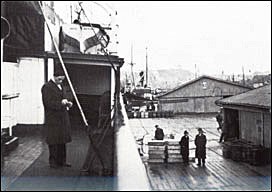
Thursday, 02 April
We have 10 passengers on board, 5 of whom are Norwegian bigwigs that sit and talk unceasingly about what’s happening in (Norwegian) Parliament, society scandals and so on. Yesterday evening the weather cleared up considerably. The moon cast an odd, milky sheen over the landscape. My father had warned me about the Foldefjord, and there we were met by severe swells. Immediately afterwards the heavens opened with a storm of frozen snow. We arrived in Rørvik well overdue, and the boat had difficulties docking as another boat was still unloading cargo in our berth. It was rather fascinating watching how they worked under the electric lamps to load and offload. Two slaughtered pigs were hoisted on board covered with snow! Early this morning Winter had left a layer of ice on the deck. The scenery is quite incredible. Everything is covered in snow now. Snowstorms alternate with sunshine. Everywhere small houses, often far from one another. We met several fishing boats on the way, all with sails hoisted.
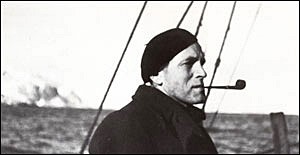
Friday 03 April
On to Bodø in a snowstorm. We didn’t get to see much of the town, only stopping for a half-hour. Then we set sail again to the Vestfjord. A strong nor-westerly breeze was blowing. Cold and particularly pleasant. At 6pm Lofoten came into sight. By around 6.45pm we were in Stamsund. We went ashore here with nor-westerly gales blowing and falling snow for company. I rang Peder Haug in Ballstad from the post office. It took a half-hour before the three telephone exchange ladies managed to get a connection. But it only cost 30 øre (NOK0.30). Besides time passed by quickly in the little room where many fishermen in oilskins were sitting and carrying on manly conversations (“Gespräche der Männer unter sich”) as Nesch called it, freely quoted from Brecht. They also had a unique way of booking telephone calls via the three ladies without actually knowing the telephone number. I eventually spoke to Peder Haug and told him we weren’t too far away. Peder Haug is the manager of the Bergen firm W.A. Mohn’s fishing hamlet, Kræmmerviken. Then we took a taxi over the snowy mountain on an extremely narrow and hair-raising road at impressive speed and were met at Kræmmerviken by Mr and Mrs Haug. They had a cosy, little wooden house. There we enjoyed supper. Nesch couldn’t keep still, so full of excitement over the magnificent Lofoten landscape, which was even more magnificent than he had ever dreamed.
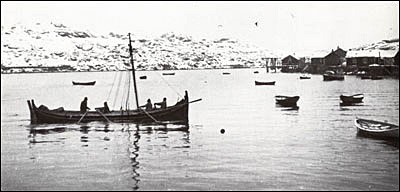

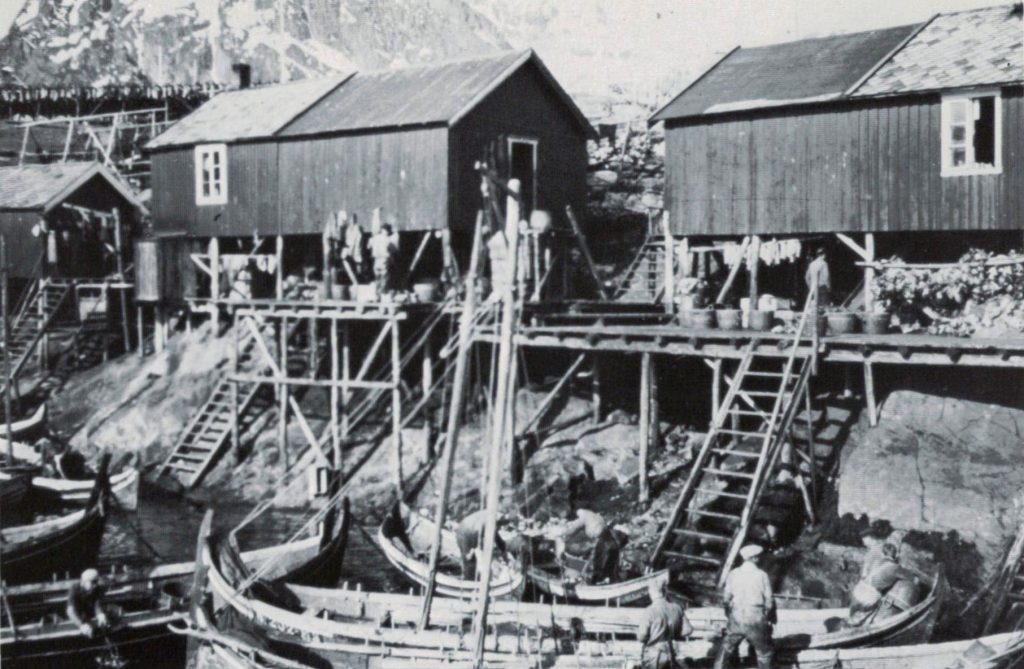
Friday evening
We slept very well under thick woolly blankets, and the next morning Mrs Haug served us coffee in bed. While we washed; Nesch quoted poems by Uhland and Schiller. After breakfast Haug showed us Kræmmerviken’s fishermen’s shacks.
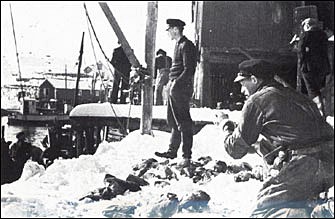
We saw two boys baiting lines; attaching frozen herring to the hooks. Up to 700 baits on one line, which were then laid with some care in a tub. Mussels are also used as bait. Peder Haug told us that he had once seen, with his own eyes, that some fishermen had baited their lines with raisins when the cod were biting well. Fishermen sleep in these shacks on bunks under the roof. They have a little oven and cater for themselves. Now and again it snowed heavily. The bay (bukt) or cove (vik) – and probably why it was called Kræmmerviken, was dotted with such shacks. Tall mountain peaks towered right behind the shacks. There was only space otherwise for the drying racks on which to hang the fish in pairs. At 12 midday the fishermen came in from the fishing grounds. They left early in the morning to lay out lines and nets, and to haul up the nets they had set out the day before.
Between motorised fishing smacks (chug-chug-chug) also rowboats, open, Nordland fishing boats. Haug told us about the camaraderie among fishermen and that those with engines towed the rowboats when asked to do so. Somewhat of a show to see when the fishermen came in, wet, in dripping oilskins with sou’westers and huge mittens. Soon a quantity of cod lay on the wooden floor in our shed. The fishermen threw these up from their boats, with the aid of poles fitted with hooks on one end, either through open shed doors or through trapdoors in the floor. Many fish had already been beheaded on board, and roe and liver sorted in special wooden tubs or barrels. The heads were pulled up after being threaded on to a line through the gills; looked disgusting. The fish that came up still intact were sliced up in the shed, the innards taken out, the heads cut off. Everything taking place with artistic finesse.

En elderly man, who looked more than a bit like a cod himself, unshaved and with squinting eyes, always pierced the cod through the dead eyes when he threw them up. It made a weird noise. The cod were weighed, always a hundred kilos at a time, then thrown again into large water buckets . These were taken by sled or pony trap that some old geezers aided by Fjording ponies drove to the drying racks where the fish were braced and hung up to dry. There they hung like wine grapes. The heads were also hung the same way. An extreme life and way to earn a living. Nesch sketched, fishermen gathered round him in half-circles, watching with fascinated, innocent eyes. Amazing to see how confidently the fishermen steered the small boats, so heavily loaded down that most of the boat was underwater. For dinner we were served “cooked cod” from heaven, unbelievably tender and delicious. Afterwards we had a snooze, wrote and listened to the radio. The radio plays a huge role here, especially the weather forecasts and reports on fishing. Peder Haug said:
“Without the sea I would not be able to survive or make a living.”
The supervisor said:
“Weather forecasts, they are good alright, but they are normally broadcast too late. Their excuse is that the weather forecast director has just gone to Oslo.”

In the afternoon we were in a “net shed”. There sat an old man with a stylish moustache, knotting nets. It was very pleasant in the tiny wooden building. The crew of a smack live together in a shed like this. Rent is no dearer than 5 krones (NOK 5) per person. This is written up on a “tab” and settled at the end of the season. That is the way it is also done with the shopkeeper, who keeps such credit books. There are times when, if the fishing has been poor, there is not much left over. Haug told us that once an entire crew only had 2 krones at the end of the season. With regard to the fishing I would hasten to add the way the fishermen find their lines and nets again in the fishing grounds, even in thick fog, is with the aid of a watch and compass. A crucial factor in this manoeuvre are the seagulls, the “Lofot doves”, that are often huge birds and create a colossal spectacle all day long. One particularly fat cod weighed 20 kilograms. This evening there will be a lecture by a Mr. Coucheron-Aamot on Greenland. Posters with impressive photographs have alerted us to his arrival. There will also be a guest performance by “Den sterke William”, Norway’s strongest man.
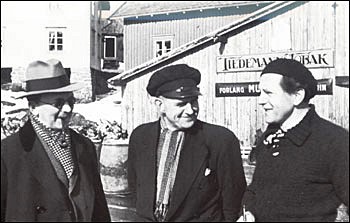
Monday morning, 06 April
On Saturday we inspected the modern cod liver oil factory, which is owned by the American firm Scott & Browne. Here the fresh liver is steam-boiled as quickly as possible in large, wooden vats at around 90 degrees Celsius. The livers were either directly delivered by the fishermen or from the buyers who rowed in the bay in a boat full of barrels and casks and buy the liver from the fishermen.

In this intense heat in the steam vats the livers soon disintegrate and the cod liver oil that appears is emptied into tanks and refrigerated at minus 2-3 degrees Celsius if the weather is not sufficiently cold outside, Then the cod liver oil is filtered through a press and then tapped into tin drums with wooden covers. Whatever was left over from the liver was compressed, and the resulting cod liver oil was also refrigerated and could be regarded as first-class goods. The residue (“grakse”) in the drums was put through a residue separator where the last drop of cod liver oil was squeezed out. Anything left over from that was bought by a man who made pressed cod liver oil. Everything had to happen as quickly as possible. Livers from netted fish fetched better prices than those caught on a line (often smaller in size). In the afternoon we sat in the coffee house and chatted with several fishermen. A splendid fishing picture hangs there that I would dearly love to own. Ballstad is divided into two at Vågen, and you are transported across by an 80-year old man with a rather marvellous beard. He shouted after Nesch that he hadn’t been paid for the ride. He is married and lives a bit further inland. Some young lads are trying compete with him. In the evening there was not enough time for Mr. Aamot. Instead Peder Haug played “Kjerringa med staven” (loosely translated “The Wife with the walking staff”) and other melodies. He could also play his violin on his back, placed behind his head. I stood a round of “White Horse”, which was helpful for Mrs Haug’s cold, and after that we slept like a rock. In Ballstad there is a wonderful little post office, where letters are sometimes read out aloud. Many letters have been placed in the window from America and other countries; for example to “fisher Jensen in Lofoten” and similar. Besides the post office and coffee house.

There is also a local mission house and youth club, a house that sells bread, a cobbler, and a dentist who is away at the moment. Sunday morning, once again coffee in bed. Peder Haug played the violin and harmonium and sang psalms. Sunday dinner with roast pork. Took photographs in the afternoon. In the evening we, including Haug, heard a lecture given by a secretary from the rescue vessel organisation Redningsskøyteselskapet. This was held in a nice, new wooden building that contained a large room for this type of function.
Cutting Thursday, 09 April. Sørvågen in Lofoten.
The lecture was rather amusing, and the audience even more so. The women sat to the left, the men to the right. Girlfriends and married couples on the women’s side. Peder Haug acted as a kind of organiser. Afterwards we sat together with the lecturer over a cup of coffee in the basement. Then there was a tombola raffle. Very relaxed and pleasant. Peder Haug played in an amateur orchestra on the stage – behind a curtain. At 11pm we were served food again. Haug told us stories and we enjoyed a dram. Then we sat and waited for the “local transport” to toot its horn. It should have been here at twelve-thirty. Around 2.30am we finally left Haug, who truly had waited up just for our sakes. A sensitive man. Oh look, here comes the boat. It had snowed heavily, and we waded our way through the deep snow. None of the crew were to be seen. I lay down in the lounge, with my coat over me. Nesch still wandered about up on deck. We made several ports of call. Around 6am a gentleman came into the lounge and asked in German: “Where is Carl?” It was Mr. Mohn Snr. We were in Reine when Mr. Mohn came on board. The boat continued to Sørvågen. The fishermen were just about to leave, and that was quite a fascinating sight. With the aid of a rowboat we came ashore in Sørvågen, while Mohn continued on to Aa. We moved into Frithjof Arntzen’s house, who owns just about all of Sørvågen, and also takes in house guests. After the idyllic days spent in Kræmmerviken we were somewhat disappointed. So, we wandered down to the quay. Everything is so much bigger here. Around 900 boats in the harbour. A hive of activity.
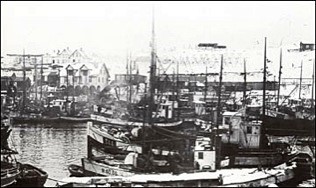
Our attention was drawn to an “ottring”, a rowboat fitted with a mast for a mainsail and foresail, for a ten-man crew. Photographed the crew from every imaginable angle, and Nesch christened them “Vikings”. They were first-rate fellows.

Dinnertime at Arntzen was typical table d’hôte with only Norwegian guests where no one said a word. In the afternoon we found a very cosy coffee house located in the post office building, and we quickly made friends with the “coffee girl”, the girl behind the counter. The counter also serves as a bar and is very snug. Specially with the wood stove close by. Here you could buy coffee and prune compote, said to be the number one favourite among fishermen. The girl hailed from Helgeland and was very popular with all of the guests.
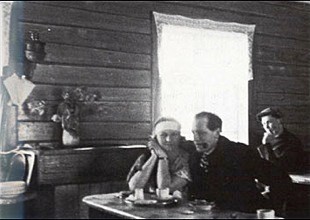
After that we drank more coffee at Arntzen’s, and leafed through some old, worn-out newspapers that announced the League of Nations would be meeting soon to discuss the occupation of the Rhineland and Hitler’s subsequent declaration. Then Mohn turned up and took us to Aa along a scenically beautiful road with an amazing view to the Lofot mountain chain on both sides, the sea and islands of Værøy and Røst. It was low tide and a broad, black strip lay between the sea that glistened with the colours of the evening and the snow-decked mountains. In Aa we were met by Mohn’s host and friend Hennum, where we were royally entertained in a highly original home. Nesch was in fine fettle. Hennum played Chopin on a piano that was in bad need of tuning. On the walls hung pictures painted by Hennum, and small rugs that were nonetheless not rugs, but paintings – also by Hennum. He complained that due to this work his eyesight was ruined, and he told us about his Italian mother. Mohn was also in tip-top humour and Nesch was almost +tipsy and told stories about Sonja Henie. Back to Sørvågen under a romantic, full moon through this enchanted landscape.
Easter Sunday, 12 April, Stamsund
Tuesday brought calm, good weather. Strictly speaking, we should have been out on the fishing grounds with a fisherman, but didn’t get out of bed in time. In fact, Nesch and I slept until half past eleven. After we had eaten Nesch went over to draw, but we paid a visit to the coffee girl first. I inspected the Mohn firm’s cod liver oil factory. Visit to the Vikings at fishermen’s shanty. They had heaps to do and tubs full of lines. The line is laid down with exacting care and all hooks baited with frozen herring. All this took place at a whirlwind rate, and the jovial chaps even competed with each other about who would be finished first “because competition is the law that rules on the sea”. We just stood there and gaped. In the evening we were back at the coffeehouse where we found some of our Viking fellows again. We sat together and they told us a bit about where they were from and their farmlets. “It’ll be fine weather tomorrow,” the said. Nesch and I were due to sail out with a net boat that Mohn had set up for us. Due to all the coffee and excitement we hardly slept a wink. At 5am the fisherman turned up and threw snow at the window. Nesch was the first one out of bed. “Do you want to come along, it’s close to gale conditions out there?” “Yes,” Nesch shouted back. We got dressed in a hurry. I pulled three jerseys on, one after the other. The fisherman threw more snow and shouted we had to get going straight away. No time for breakfast. We hauled on our oilskins that Mrs Arntzen had lent us, and a rucksack containing breakfast and two thermoses of coffee. Rowboat out to the smack. Many smacks were already on their way out. Everywhere you could hear the sound of chug-chug-chug. Hardly a word was spoken, everything carried on in utter silence. We waved to our Vikings as they rowed past. Out to the open sea. A quick gulp of cognac. Suddenly, there were the breakers. We glanced at each other with in trepidation in our faces! Past the last rocks and then we were out in the midst of the weather. Now began a fantastic dance. In addition to the storm, snow and wind whipped our faces. We stood behind the wheelhouse and held on for dear life to the stays. Unforgettable sight: our Vikings, who we now caught up with again! Suddenly their boat turned up out of the whirling snowstorm and then they were gone again. They sort of “clambered” over the peaking waves. We also passed some two-man rowboats. All of the boats handled the sea incredibly well. That was the case with our smack too, even when you thought: uh oh, ‘she’s’ going to keel over, and water surged over the boat, to and fro. After a while you just became somewhat apathetic. Later I was sick four or five times, but funnily enough it strengthened me in a way. In the midst of this chaos the fisherman found his nets. He immediately cut the engine and shouted; “We’re here”. Some of the crew hoisted the ‘besan’ sail astern.
Where I stood, from time to time, all the water that had accumulated in the lifeboat deluged on to my head. Then we hauled up the net. Only eight cod; a very poor catch. The cod were quite “done for” when they were hauled on board and finished off. They only pulled in one net. The result was too poor. We hopped over to the next smack to see how they had got on. Both boats bobbed up and down on the waves. On the home trip land came into sight about half past ten, and the weathered cleared a little. The skipper’s 15-year old son stood at the helm on the way home.

In spite of everything I was glad to get back to the port. Soaked to the skin, and hands and feet so clammy I was almost unable to move them. I imagine we looked pretty bedraggled. In any case our Vikings greeted us with a Indian (Redskin) whoop and asked concernedly how it had gone with us ….. We changed our clothes and tried to warm ourselves up by the oven with the help of some coffee. In the end only a few fingertips still felt like they were made of ice. While Nesch visited the Vikings I entertained myself with an painter by the name of Rasmussen. He looked like Ramon Navarro, an utterly flaw-free young man. Then it was time for prune compote served by the coffee girl. In the afternoon it was time for a stroll and taking photographs. In the coffeehouse sat an old man, whose one solitary tooth showed when he smiled, and a little dog. He sold landscape prints and seals, some with religious motifs. Also a play with a murder plot, and if that wasn’t enough he could read your fortune in the cards. Later in the afternoon we were on the other side of the port and walked under hundreds of dead fish hanging to dry on the racks. Nesch sat atop a rock, drawing and etching the view over the sea.. The weather had improved considerably and Viking friends had surely left for the fishing grounds again. They needed to haul up the lines as it is a sacred day tomorrow. You are only allowed to set out lines and nets on Long Friday. Coffee again (in Sørvågen almost 6 times a day). A lady pharmacist from Vardø was there on a visit to Arntzen. Her stories about the Saami people fascinated us and made us yearn to visit the county of Finnmark. Our hostess introduced us to an older man whose job at the port was cutting off cod heads. His (family) name was Seivåg and had started painting as a 60-year old after a stroke. He was an engaging fellow and when he spoke I noticed only one half of his mouth moved. Later we saw his paintings that hung in various businesses in Sørvågen and also in his home. He had painted very attractive landscape pictures, and twice painted the murdered Lindbergh baby, portraits of women ( a French lady and an actress) and a painting of an Atlantic ship. Nesch gave him the address for the Artists Society in Hamburg, who might be interested in an exhibition of his works. I bought one of his pictures that depicted “the boot”, a mountain formation near Sørvågen, and Nesch, in his typically kind way, gave Seivåg a book on old German miniatures. After supper we visited our Viking friends and took a bottle of whisky from my suitcase along with us. The Vikings ‘chieftain’s’ daughter, who slept in the same bunk as her father, is very sweet and moves like I imagine a Japanese princess would. She boiled some water and we made a toddy. We had a delightful evening with these excellent people in the cosy fishermen’s shanty where the bunks lined the walls and hammocks hung from the ceiling, and where the fishermen slept; two to a bunk. The toddy tasted good. Fishing stories were exchanged and Nesch told us about his time as a soldier in the World War I. Some of the fishermen had read “Intet Nytt fra Vestfronten” (loosely translated: “No News from the Western Front”). “We all read books that we can talk about afterwards,” they said. In the end they etched their names on a copper plate that Nesch had taken with him. Some had already climbed up into their bunks, and by the time we left, there were several bare feet poking out from under bedcovers. At Arntzen’s we received coffee and liqueur again. That was indeed very pleasant and Mrs Arntzen filled up our glasses with even more liqueur. The mood became even more convivial and we danced to music from the radio and gramophone to the wee small hours of the morning.

Cutting Thursday
In reality, we should have left this afternoon; our suitcases were packed when the boat sounded its horn. But Mrs Arntzen wouldn’t let us leave and promised a big dance evening. So we stayed. In the afternoon I read “Nordlands Trompet” (Nordland’s Trumpet”) by Petter Dass. Nesch and Rasmussen discussed art, canvas paintings and the “primitive” factor. Then Nesch and I went for a walk again and discussed art. On the way we lots of people: fishermen in Sunday attire. Many were still out on the road until very late at night, and there were a few fights. Some had drunk so much Easter brew that they nearly couldn’t walk. Our Vikings told us the next day that these were not fishermen, but locals from Sørvågen! Back at Arntzen’s we partied until half past four in the morning. The lady from the post office whom we had nicknamed Miss Post was also there. Who would ever have thought she was so sweet and amusing?
Long Friday
Up at nine o’clock. The coffee girl, who also works for Mr. Arntzen, served us coffee in bed. Beautiful weather. I visited our fisher friend Rasch while Nesch continued to sleep. I was given a dram of Curacao. In Rasch’s lounge there was a picture of a sailboat where Jesus steered in a multi-pleated coat, with a halo over his head. After breakfast at the Arntzens we chatted with the other guests, and a pleasant young dentist who had travelled from place to place in Lofoten together with his sister, related about a formidable contest for business between him and a dental technician. The technician had actually manufactured a set of dentures at a price of NOK 15, all inclusive. At 4 o’clock that afternoon we sailed on a fishing smack to Reine. Our smack skipper had dined at the Arntzens and had caught my eye with his elegant clothes, especially with his double-breasted vest. We also had a vicar on board, with stiff collar and turned-back corners, and also a sixpence cap. At Reine we checked into a small hotel where it appeared the only lodgers there worked for the landowner who owned the fishing hamlet, so to speak. The scenery at Reine is unparalleled, almost “too pretty”. We had not been able to let landowner Sverdrup know we were coming to Reine, because the telephone connection had been closed due to the public holiday Long Friday. Neither did we dare let him know after we arrived. In the evening at the hotel Nesch got talking to a young man who offered to row from fishing boat to fishing boat to hear who could take us out the fishing grounds the next morning. In the end the inspector’s boat was happy to take us along. While Nesch continued to play bridge in the hotel lounge I retired for the evening. The beds in Lofoten are made up in an unusual way. The cover blanket is placed as a small roll in the middle of the bed. It looks nice, but I cannot for the life of me figure out the point of such an operation.
Easter Saturday morning
The girl at the hotel was supposed to have woken us at 5am. Nesch jumped out of bed and yelled: “She’s forgotten us!” Well, I leapt up as well, and of course Nesch was right, she had forgotten us! As we washed, a man from the inspectors’ boat knocked on the door and called out that it was almost half past five and we had better hurry up. As fast as we could we hastened to the quay and out to the boat. Everywhere we were met by the sounds of engines beginning to chug, the harsh cry of seagulls. Smack after smack departed with ‘ottring’ rowboats also in their midst. At the exit from the harbour everyone waited for the signal, a flag that was raised at 6 o’clock. Then it was full steam ahead for the fishing grounds. The weather was marvellous and the sea smooth as a mirror. The “policemen” on board the inspectors’ boat were very pleasant, joking with each other, sang duets and one of them even played the piano accordion. Real Easter Evening atmosphere. The inspectors’ boat drove around the entire fishing grounds. At 7.30pm the flag was raised on the inspectors’ boat, which signalled the fishermen could start pulling up their nets and lines. The sea is divided up precisely into ‘net sea’ and ‘line sea’. The inspectors’ boat had to stop several smacks that had breached the law. They were written up. Sometimes this took place with some drama; pursuit, yelling and wild gesticulation. Entertaining to see the so-called “cheater fishermen” who fish with “deep bait”. There must have been hundreds of boats floating together. Everywhere arms moved up and down to “trick” the fish to take the bait. The besan sails’ brown colour stood out against the white mountains and the brilliant blue sky. We were supposed to travel further with the local boat at 7pm, but the boat did not arrive. We waited until 3.30am that night. It was awful. I went outside several times to stay awake as it was so hot in the hotel’s lounge. After a while the fire went out and it became quite cold inside. All across the northern heavens danced the fantastic Northern Lights in shades of light green. The boat finally showed up at 4.30am. By then it was almost light outside, and the seagulls were screeching again already or maybe they were just still screeching. A thin layer of ice lay on the water. It was the same boat that had taken us from Ballstad to Sørvågen. By nine o’clock we were in Stamsund.
Easter Sunday, 12 April
On this trip the names on our tickets were “Olsen” and “Hansen”. The clerk at Reine thought our manes were much too difficult, and I suggested he used Norwegian names. Then he chose these. Nesch thereby became Olsen and I Hansen, and we discussed who was now the finest. The ‘dispute’ reached a climax later when Nesch referred to kinship with for example Fred. Olsen. That is when I had to give in. Beautiful weather in Stamsund, Easter sunshine and a proper hotel spelt with two ll’s . We had a wash and ate breakfast with Easter eggs and bright yellow paper serviettes.
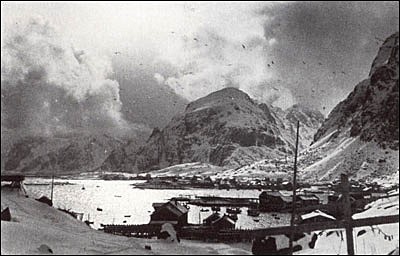
Saturday, 25 April (written after our return to Slependen).
The Easter sun disappeared quickly, but the landscape at Stamsund that had so impressed Nesch from the very first moment, certainly did not disappoint. By the afternoon we were so tired we went and had a nap, thereby missing the big event of the day: the arrival of the coastal steamer, where all of Stamsund met up on the quay. We went for a walk and it started to rain. Here too, practically only men present. We popped into the Salvation Army. Inside everything was dignified, another story out front. I had left my business card with the “tsar” yesterday, Mr. J.M. Johansen, who is owner and “King” of Stamsund. In the afternoon the next day I received a message from the girl at the hotel that I could get to see him. First we went to the local coffee house where you can play music on a gramophone with a horn. Those fishermen still here, were out fishing today and the atmosphere was hardly festive in Stamsund this Easter Monday. It was a normal workday. I was received by the “tsar” around 5pm at his office. He didn’t have the forceful speaking voice that would have suited his title, but otherwise seemed impressive enough. All of Stamsund is more or less landowner Johansen’s work. It is impressive to see what has been created, the massive quay, cod meal factory, cod liver oil plant and tanker facility. It is said that Johansen supplies half of North Norway with solar oil. Many stories are told about the “tsar, and we got the impression most people admire the man, even if the “empire” was naturally not created without some rough handling. Johansen lives in a large brick villa, and rumour has it he has a telephone in each room, and that electric lights burn in all of the rooms all day long.
Nesch, who throughout the years has dreamed and hoped for the big commission from the authorities or rich folk, pointed to the massive rock face vis-à-vis the quay and told him about the large material picture he would create there directly on the rock face, in honour of the tsar, if only the port/land owner would give him such a commission…… But the tsar naturally had other things to think about than an unknown German emigrant artist. On the trip to Svolvær we passed Henningsvær and Kabelvåg. We were incredibly lucky with the weather and there was not even a whisper of wind. Nesch tried without success to cheer up a girl, who looked like a mouse and described herself as “very serious”. Aboard the boat we met up again with our painter friend from Sørvågen, Mr. Seivåg, and as usual the topic of conversation between “Olsen” and him was about problems concerning art. From Svolvær in excellent 2-man cabins we are on deck aboard the M.S. “Lofoten”, a very comfortable and new ship. While the sun set behind the Lofot mountains some fishing smacks chugged past on their way home from the fishing grounds. On the other side the coastline of the mainland. The blue-white mountain chain that reminded one of photographs from Greenland, the light blue sea, smooth as a mirror, a pale blue heaven: forever etched in my memory. There were many Lofot fishermen on the ship on the return voyage. Some had their rowboats and equipment stacked up on the coastal steamer’s deck. They were returning home to Beiam, Nordland, Helgeland and other places. Passing the “7 sisters” we saw there was still snow on the mountains. On board was also Mr. Carl-Johan Sverdrup, one of the Sverdrup brothers who resides in Naples and who dressed like an Italian. Nesch thought he looked like Peer Gynt with white hair and trimmed whiskers, and he was most pleasant towards us. The voyage passed by much too quickly. The next morning we were in Trondheim at 7am, and by 8am we were on the train to Oslo. We were somewhat disappointed to see there was still a lot of ice on the river Mjøsa. It even started to snow. We had dreamt about Oslo bedecked in a green canopy of freshly flourishing leaves. At Slependen it was raining, but at least the fjord was free of ice. Mrs Nesch met us dressed in new clothes, she had painted two new paintings, baked two cakes and a loaf of bread and made two candlesticks. Great joy all round with this reunion, coffee and cakes. Only then did Mrs Nesch relate about everything she had got up to in her time alone. The journey was at an end. It was time to return to everyday living.
Postscript, May 1976
It was Rolf Nesch’s son-in-law Eivind Otto Hjelle who retrieved my (this year) exactly 40-year old diary from out of the writing desk drawer. In the meantime the master has passed away at the age of 82 years. Back then, – in 1936 – he was 43 years old and I was 24 years old. We knew each other from Hamburg. My father was a passionate art collector and had showed Rolf Nesch his large collection of Munch graphics. My father also had a firm in Hamburg engaged in import and export of fish oil and cod liver oil, and since 1905 a similar firm in Oslo. He resided for a number of years in Oslo, was married to a Norwegian lady and was fluent in Norwegian. Through him Rolf Nesch became interested in Munch and in Norway, and when he felt persecuted as an “homogenous” artist after Hitler’s takeover of power it was natural that Nesch chose Norway. I arrived in Norway in 1934, somewhat later than the Nesches. Meanwhile Nesch had rented the 2nd storey of a small wooden villa in Slependen, close to the station. Later on he would rent a spacious house with a large section and garden leading down to the Vestfjord at Nesøen – not far from the distinctive wooden bridge. This is where I moved in, as a tenant in “Grønsund” Villa at the beginning of 1936. The daughter of my uncle, landowner Wilhelm Mohr in Bergen was married to W.M.A. Mohn, whose father owned the fishing hamlets of Kræmmerviken and Moskenes in Lofoten. My father had the brilliant idea of asking Mohn if he would be willing to help Nesch and myself to settle in up there in the North – I was supposed to familiarise myself with the business, say Hello to suppliers, and Nesch – who had managed the transition to the new conditions remarkably well (see graphics series “Sne” (“Snow”) that was created in Slependen) – was on the hunt for new impressions – unbeknown to him then that Lofoten would come to mean to him in the same way as the South Seas’ islands would mean to Paul Gauguin. Lofoten in 1936 was an idyll – the people there seemed so open and unspoiled, especially for someone coming there from Hitler’s realm. An idyll – even if associated with extreme toil for the fishermen – often a fight for one’s life on the Lofot sea with – on the basis of modern expertise – inadequate equipment. But – this was also what Nesch was seeking – following his experiences as a soldier at the front in a World War; the camaraderie in a shared battle, to do one’s duty to the best of one’s ability – and afterwards: to party! Nesch knew I was keeping a diary, and we fantasised about a book with his lithographs and drawings, our photographs, my notes. But Life became increasingly difficult for us both, especially for Nesch. Due to unfortunate circumstances my father was forced to reduce the financial support he had given to Nesch. There was still no one in Norway that wanted to buy any works from Nesch, the “odd German”. Then came the war, the occupation of Norway and a whole string of other things. After degradation, hard slog, hunger, accidents and an incredibly tough endurance and faith in one’s self, he finally gained the recognition, some years after 1945 – and at last, world fame. Net fisherman Haftor Rasch from Sørvågen – the one who showed us the Lofot sea in the midst of a storm – wrote a letter to me at Christmastime every year after 1936. He was in fact the only one of our friends up there that got to know about Nesch’s saga and in the end about his ultimate triumph. Sadly, he has also passed away now and will not get to see his name, hear my thanks in this little book – 40 years on.
C.H.H.
All photos by Carl H. Hudtwalcker
Copyright: John Michael Hudtwalcker Norwegian text Originally published by Rolf Nesch-Forlaget, Oslo, 1976
ISBN 82-990124-1-4
English translation by Noricom AS, Oslo, Norway
www.hudtwalcker.com 2014
